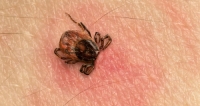Benefits Of Plant Extracts In Lyme Disease (Part 1)
As summer approaches and people start outdoor activities, the season also brings an increased exposure to insects and insect-borne diseases. According to the Centers for Disease Control and Prevention, insect-borne diseases in the US increased more than three times in the last decade. Ticks, mosquitoes, and fleas are the most common carriers of these diseases and they especially increase during longer and hotter summer days.
Lyme disease is one of the most common tick-borne diseases accounting for 3 in 5 cases of insect-borne diseases. It is found in more than 80 countries. In the US it is mainly found in the northeast, midwest and along the Pacific coast. Approximately 476,000 new cases of Lyme disease are diagnosed in the US every year, and close to two million people could be suffering from chronic Lyme disease.
The human transmission of Lyme disease starts from ticks that feed on blood from humans and animals such as pets, deer, mice, birds, squirrels, and some reptiles. A tick becomes infected by pulling bacteria (classified as genus Borrelia) from the infected host. Borrelia sp. exists in three morphological forms which are: the active forms (spirochetes), and the latent forms (rounded forms and biofilm). These morphological forms allow the bacteria to survive and change even in hostile environments.
Most of the early stages of Lyme disease are misdiagnosed because of vague symptoms of generalized inflammation. Initially Lyme disease affects mainly the skin; however, at its later stages, known as disseminated and chronic Lyme disease, the inflammation spreads to the joints, nervous system, the heart, muscles, and other organs. There is a common perception that patients treated with antibiotics at the early stages of Lyme disease recover rapidly and completely, and that the later disease stages can be treated effectively, although recovery is slower. However, approximately 20-40% of the patients taking antibiotics may face persistent and recurrent symptoms such as joint and muscle pain and chronic fatigue. The symptoms can last for many months or even years, lowering a patient’s quality of life and making subsequent treatments more difficult to succeed. Long-term antibiotic treatments are often associated with serious side effects and usually are not recommended. The fact that these treatments do not prevent a reoccurrence of the disease indicates that antibiotics cannot effectively eliminate or disable the bacteria in the body.
The researchers at the Dr. Rath Research Institute have tested 45 natural compounds against two species of Borrelia: Borrelia burgdorferi sensu stricto (the pathogen causing Lyme disease in the US) and Borrelia garinii (the pathogen causing Lyme disease in Europe).1 The results have shown that all tested compounds could inhibit bacterial growth of spirochetes. The latent and most difficult forms of Borrelia to eliminate were susceptible to cis-2-decenoic acid, rosmarinic acid, baicalein, monolaurin, luteolin, and kelp (iodine). These compounds also induced death of the latent rounded forms. Five of the compounds, baicalein, luteolin, monolaurin, cis-2-decenoic acid, and kelp (iodine) could also reduce biofilm-like colonies formed by Borrelia burgdorferi. Only baicalein and monolaurin could reduce biofilm formation by Borrelia garinii. Our researchers also compared the efficacy of these compounds to doxycycline, (the most common antibiotic used in treatment of Lyme disease). The results confirmed that when given together, the plant extracts and micronutrients increased the efficacy of doxycycline.2
Due to frequent misdiagnosis or late diagnosis, diseases such as Lyme disease can devastate patients and their families, causing significant suffering before being treated. The researchers at the Dr. Rath Research Institute are continuing to explore safe and effective options for addressing Lyme disease.
Ref:
1. Goc A, et al., Journal of Applied Microbiology 2015, 119: 1561-1572
2. Goc A, et al., International Journal of Biological Sciences 2016; 12(9): 1093-1103.
